Military ranks of the Philippines
The following list presents the ranks and insignia of the Armed Forces of the Philippines, one of Asia's oldest armed services.
Introduction
The current Philippine military ranks are inspired partially by the very first military insignia used by the military forces during the Philippine Revolution of 1896 and the Philippine–American War, and the insignia used by the Philippine Constabulary raised in 1902 during the final days of the Philippine–American War, which was basically the same style of insignia used by the United States Army at that time. Elements of both the US army ranks and the old Philippine Army appear in the current ranks; this was reflected at the general officers insignia and enlisted ranks that resembled those of the US military (the silver stars used by generals and admirals were used by field grade officers in the First Republic), the field officers [like colonels], whose insignia are suns, use those insignia used by general officers of the Revolutionary Army. Company rank insignia[i.e. captain], consisting of a silver triangle, are a recent creation. Both company grade and field grade officer insignia have the baybayin letter ka ( K) in the middle, another throwback to the days of the war for independence, and even in the medal used by second-level members of the Katipunan during meetings, in which the letter is in the center.
Revolutionary Army ranks
These rank insignia for the nascent army were created in late 1896, replacing the earlier rank insignia used by the Katipuneros containing the letter K (ka). Ranks were then worn on the sleeves of all uniforms.[1]
Shoulder epaulette insignia was introduced in late 1898, some time after the declaration of Philippine independence. It is worthy of mention that the insignia for the rank of Second Lieutenant and Major has three silver and gold stars, respectively, and the number of stars are reduced when promoted.
Officer ranks
| Revolutionary Army ranks | Tagalog Name | Spanish Name | Sleeve insignia | Shoulder epaulette insignia (1899–1901) |
|---|---|---|---|---|
| Minister Marshal | Ministrong Mariskal | Ministro Mariscal | ||
| General | Heneral | General | ||
| Lieutenant General | Tenyente Heneral | Teniente General | ||
| Major General | Heneral ng Dibisyon | General de División | ||
| Brigadier General | Heneral ng Brigada | General de Brigada | ||
| Colonel | Koronel | Coronel | ||
| Lieutenant Colonel | Tenyente Koronel | Teniente Coronel | ||
| Major | Komandante | Comandante | ||
| Captain | Kapitán | Capitán | ||
| Lieutenant | Tenyente | Teniente | ||
| Alférez
(putative) |
Alpéres
Ikalawang Tenyente |
Alférez
Segundo Teniente |
Present rank insignia of the Philippine armed forces
The current AFP insignia used today are a modification of the system first used in 1954–55 as part of the Filipinization of the military forces by then President and former Secretary of National Defense Ramon Magsaysay, ending years of the US-styled rank system in place since 1935. Prior to that period, the Philippines used the same rank insignia of the United States Armed Forces with modifications for Philippine conditions.[2][3]
Officer ranks
| Officer Ranks (English) | Officer ranks (Spanish) | Battledress collar insignia (Army, Air Force and Marines) |
Full dress shoulder insignia (Army and Air Force) |
Army Service dress shoulder insignia | Air Force Service dress shoulder insignia | Navy white dress shoulder insignia |
Navy full black dress sleeve insignia |
Navy and Marine Corps service dress collar insignia |
|---|---|---|---|---|---|---|---|---|
| General/Admiral | General/Almirante |  |
 |
 |
 |
|||
| Lieutenant General/Vice Admiral | Teniente General/Vicealmirante |  |
 |
 |
 |
|||
| Major General/Rear Admiral | General de Division/Contraalmirante |  |
 |
 |
 |
|||
| Brigadier General/Commodore | General de Brigada/Comodoro de Armada |  |
 |
 |
 |
|||
| Colonel/Captain | Coronel/Capitan de Navio |  |
 |
 |
 |
|||
| Lieutenant Colonel/Commander | Teniente Colonel'/'Comandante |  |
 |
 |
 |
|||
| Major/Lieutenant Commander | Comandante/Teniente Comandante |  |
 |
 |
 |
|||
| Captain/Lieutenant Senior Grade | Capitan/Teniente de Navio |  |
 |
 |
 |
|||
| First Lieutenant/Lieutenant Junior Grade | Teniente Primero/Teniente de Fragata |  |
 |
 |
 |
|||
| Second Lieutenant/Ensign | Teniente Segundo/Alferez de Navio |  |
 |
 |
 |
|||
Enlisted personnel
Note: currently senior NCO rank insignia for personnel promoted recently to these ranks in the Philippine Marine Corps, and since 2019 the enlisted and NCO personnel of the Philippine Military Academy Band sport US style enlisted rank insignia.
Army and Marines
| Ground forces ranks (English) | Army and Marine Corps battledress collar and Army service dress sleeve insignia |
Marine Corps service dress sleeve insignia |
|---|---|---|
| First Chief Master Sergeant | ||
| Chief Master Sergeant | 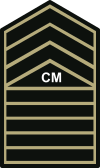 |
 |
| Senior Master Sergeant | 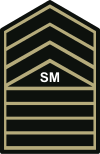 |
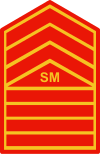 |
| Master Sergeant |  |
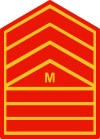 |
| Technical Sergeant |  |
 |
| Staff Sergeant |  |
 |
| Sergeant |  |
 |
| Corporal |  |
 |
| Private First Class |  |
 |
| Private | ||
Air Force
Until the early years of the 21st century the Air Forces sported the same enlisted insignia as the other services, its current enlisted rank insignia mirrors that of the United States Air Force, with the use of the national diamond roundel.
| Air force ranks (English) | Battledress collar insignia | Service dress sleeve insignia | Full dress sleeve insignia |
|---|---|---|---|
| First Chief Master Sergeant | |||
| Chief Master Sergeant |  |
 |
 |
| Senior Master Sergeant |  |
 |
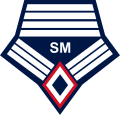 |
| Master Sergeant |  |
 |
 |
| Technical Sergeant |  |
 |
 |
| Staff Sergeant |  |
 |
 |
| Sergeant |  |
 |
 |
| Airman First Class |  |
 |
 |
| Airman Second Class |  |
 |
 |
| Airman |  |
 |
 |
Navy and Coast Guard
| Naval enlisted ratings (English) | Collar insignia | Sleeve insignia (Navy) | Sleeve insignia (Coast Guard) |
|---|---|---|---|
| First Master Chief Petty Officer | |||
| Master Chief Petty Officer |  |
 | |
| Senior Chief Petty Officer | 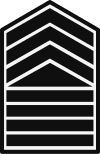 |
 | |
| Chief Petty Officer |  |
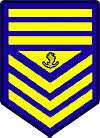 | |
| Petty officer, first class |  |
 | |
| Petty officer, second class |  |
 | |
| Petty officer, third class |  |
 | |
| Seaman First Class |  |
 | |
| Seaman Second Class |  |
 | |
| Apprentice Seaman | |||
See also
References
- Alvarez, Santiago V. (1992). The Katipunan and the Revolution: Memoirs of a General : with the Original Tagalog Text. Ateneo University Press. p. 50. ISBN 978-971-550-077-7.
- Shoulder Ranks (Officers), The Philippine Army.(archived from the original Archived August 1, 2009, at the Wayback Machine on July 1, 2012)
- Philippine Military Rank Insignia, Globalsecurity.org.